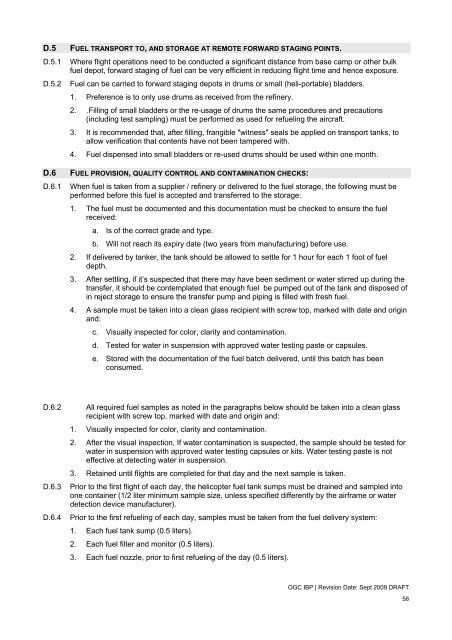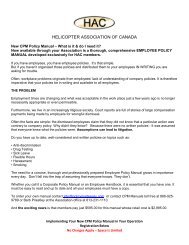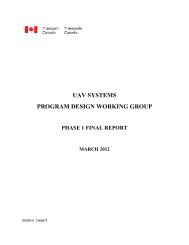HAC Oil & Gas IBP - Helicopter Association of Canada
HAC Oil & Gas IBP - Helicopter Association of Canada
HAC Oil & Gas IBP - Helicopter Association of Canada
Create successful ePaper yourself
Turn your PDF publications into a flip-book with our unique Google optimized e-Paper software.
D.5 FUEL TRANSPORT TO, AND STORAGE AT REMOTE FORWARD STAGING POINTS.D.5.1D.5.2Where flight operations need to be conducted a significant distance from base camp or other bulkfuel depot, forward staging <strong>of</strong> fuel can be very efficient in reducing flight time and hence exposure.Fuel can be carried to forward staging depots in drums or small (heli-portable) bladders.1. Preference is to only use drums as received from the refinery.2. . Filling <strong>of</strong> small bladders or the re-usage <strong>of</strong> drums the same procedures and precautions(including test sampling) must be performed as used for refueling the aircraft.3. It is recommended that, after filling, frangible "witness" seals be applied on transport tanks, toallow verification that contents have not been tampered with.4. Fuel dispensed into small bladders or re-used drums should be used within one month.D.6 FUEL PROVISION, QUALITY CONTROL AND CONTAMINATION CHECKS:D.6.1 When fuel is taken from a supplier / refinery or delivered to the fuel storage, the following must beperformed before this fuel is accepted and transferred to the storage:1. The fuel must be documented and this documentation must be checked to ensure the fuelreceived:a. Is <strong>of</strong> the correct grade and type.b. Will not reach its expiry date (two years from manufacturing) before use.2. If delivered by tanker, the tank should be allowed to settle for 1 hour for each 1 foot <strong>of</strong> fueldepth.3. After settling, if it’s suspected that there may have been sediment or water stirred up during thetransfer, it should be contemplated that enough fuel be pumped out <strong>of</strong> the tank and disposed <strong>of</strong>in reject storage to ensure the transfer pump and piping is filled with fresh fuel.4. A sample must be taken into a clean glass recipient with screw top, marked with date and originand:c. Visually inspected for color, clarity and contamination.d. Tested for water in suspension with approved water testing paste or capsules.e. Stored with the documentation <strong>of</strong> the fuel batch delivered, until this batch has beenconsumed.D.6.2D.6.3D.6.4All required fuel samples as noted in the paragraphs below should be taken into a clean glassrecipient with screw top, marked with date and origin and:1. Visually inspected for color, clarity and contamination.2. After the visual inspection, If water contamination is suspected, the sample should be tested forwater in suspension with approved water testing capsules or kits. Water testing paste is noteffective at detecting water in suspension.3. Retained until flights are completed for that day and the next sample is taken.Prior to the first flight <strong>of</strong> each day, the helicopter fuel tank sumps must be drained and sampled intoone container (1/2 liter minimum sample size, unless specified differently by the airframe or waterdetection device manufacturer).Prior to the first refueling <strong>of</strong> each day, samples must be taken from the fuel delivery system:1. Each fuel tank sump (0.5 liters).2. Each fuel filter and monitor (0.5 liters).3. Each fuel nozzle, prior to first refueling <strong>of</strong> the day (0.5 liters).OGC <strong>IBP</strong> | Revision Date: Sept 2009 DRAFT56









